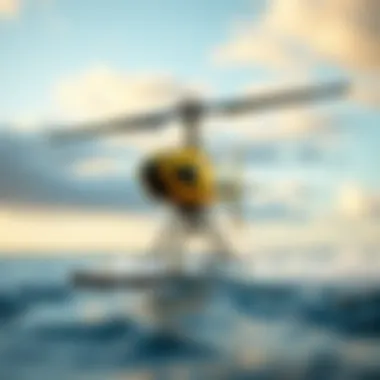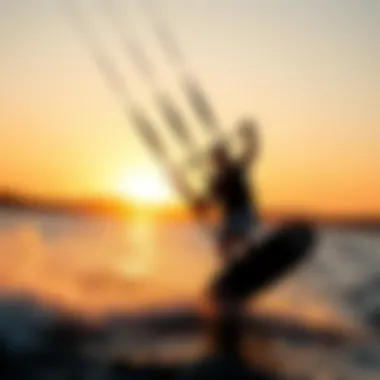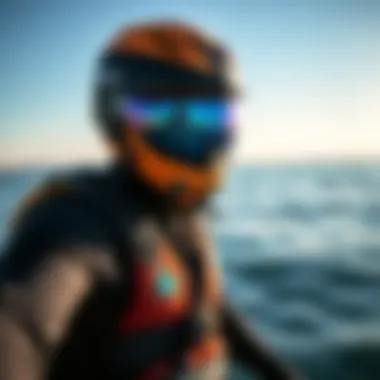Discovering Fly Efoiling: Innovation on Water


Intro
The realm of water sports is constantly evolving, and fly efoiling is one of the latest innovations capturing the attention of enthusiasts. Combining elements from kiteboarding and electric hydrofoiling, this exhilarating sport offers riders a unique experience on the water. As it grows in popularity, understanding the ins and outs of fly efoiling becomes crucial for anyone looking to dive into this world.
This article will shed light on the technology propelling fly efoils, including their design and functionality. It will also address vital aspects like rider safety, maintenance of gear, and how efoiling connects with the broader kiteboarding culture. Whether you are a seasoned rider or just dipping your toes into this emerging sport, there’s plenty to uncover about what makes fly efoiling both intriguing and accessible.
Gear and Equipment
When it comes to fly efoiling, having the right equipment is paramount. Understanding both the essential gear for newcomers and the advanced setups for seasoned riders can deeply enhance your riding experience.
Essential Kiteboarding Gear for Beginners
- Fly Efoil Board: The heart of your experience. Boards vary in size and shape, impacting how easily you can take off and how stable you'll be on the water.
- Kite: Choosing the right kite size is vital based on wind conditions. A smaller kite works well in strong winds, while a larger kite suits lighter days.
- Harness: This takes the pressure off your arms and gives you better control over the kite. Comfort plays a huge role here, so try different options before committing.
- Safety Gear: A helmet can protect against unexpected spills, and a life jacket adds an extra layer of security. Don’t skimp on this aspect.
Advanced Equipment for Experienced Riders
- High-Performance Fly Efoil: Upgrading to a more advanced board can significantly affect your ride. Look for features that enhance speed and maneuverability.
- Carbon Fiber Kite: Lighter and stiffer than traditional options, these kites can facilitate quicker turns and better response.
- Custom Fins: Tailored for your specific riding style, custom fins can make a world of difference in your tracking and control.
- Advanced Harness Systems: Consider a system that combines both comfort and feedback. The right harness can greatly enhance your performance in heavier winds.
In selecting your gear, take into account not only performance but also the learning curve as you transition from beginner to expert. Investing wisely can pay dividends in enriching your fly efoiling experience.
Remember: The right equipment is like having the wind at your back; it empowers you to soar farther and faster, just like a kite on a breezy day.
Techniques and Tips
Once you have your gear sorted, knowing how to use it effectively is the next step. Relying on solid techniques can make even the novice riders feel a sense of confidence on the water.
Basic Riding Techniques for Newbies
- Balancing on the Board: Initially, focus on your stance. Keep your knees slightly bent and your weight centered to maintain equilibrium.
- Starting Off: Find a spot with steady winds. Lay your kite downwind, and once it's in the air, gently pull on the back lines to lift off the board.
- Turning Techniques: Practice gradual turns by shifting your weight and initiating the turn with your shoulders. A smooth motion is key.
Expert Tricks to Elevate Your Skills
- Jumping: Start small; practice generating lift at lower altitudes before attempting higher jumps. Knowing how to land softly is equally important to prevent mishaps.
- Transitioning: Shifting from heel-side to toe-side effectively while maintaining control takes time. Regular practice will lead to seamless transitions.
- Advanced Maneuvers: As confidence builds, explore tricks such as spins and flips. Use your kite's power to assist, and always keep safety in mind.
Fly efoiling is as much about technique as it is about enjoying the ride. Let the dynamics of the sport unfold, and embrace the learning journey, keeping safety and fun as paramount values.
For more information on fly efoiling, visit Wikipedia or check discussions on platforms like Reddit.
By exploring these elements, we can begin to appreciate the thrill and artistry that fly efoiling offers, bridging gaps between technology and the deep blue sea.
Intro to Fly Efoiling
Fly efoiling has rapidly established itself as a thrilling new frontier in water sports, fusing the adrenaline of kiteboarding with advanced electric hydrofoil technology. Understanding this innovative sport provides essential context for both novice enthusiasts and seasoned riders. Its growing popularity also reveals insights about advancement in watercraft and the evolving tastes of outdoor adventurers.
In this section, we will dive into the definition and overview, where we elucidate the mechanics of fly efoiling, followed by a look at the history of efoil development, tracing its evolution from nascent ideas to the sophisticated machines we see today.
Definition and Overview


At its core, fly efoiling combines the power of electric propulsion with a hydrofoil that lifts the rider above the water's surface. This configuration allows for a smooth glide over waves, making the experience feel as if one is flying. Fly efoils are not merely electric surfboards; they represent a fundamental shift in how we interact with water. Riders can harness the thrill of speed, maneuverability, and the serene experience of floating just above the ocean's surface.
The sport appeals to a wide audience—those who crave speed, those who enjoy the tranquility of gliding over water, and even those who seek to capture unique experiences for social sharing. Sustainable energy consumption is a driving factor, as riders can explore vast expanses with minimal environmental impact, thanks to the electric motors.
History of Efoil Development
The journey of efoiling started with the humble intentions of innovating traditional water sports equipment. Early attempts can be traced back to the 2000s, when water sports enthusiasts began tweaking existing setups to experiment with hydrofoils. However, it wasn't until the late 2010s that the technology truly exploded. Companies like Lift Foils and Waydoo launched dedicated efoils, revolutionizing water sports. These manufacturers introduced boards specifically designed for electric motors, allowing even novices to feel like experts.
Milestones in this chronology highlight the technological hurdles faced, such as battery life and motor efficiency. Riders eagerly pushed the limits, demanding products that catered to performance and ease of use. Over the years, developments in lithium battery technology have allowed for longer sessions on the water, which has notably boosted the sport's appeal.
Overall, the evolution of fly efoiling encapsulates a blend of engineering ingenuity and community enthusiasm, setting a foundation for future developments and innovations. This exploration of the past helps understand the technological advancements that have shaped the modern fly efoil experience.
"In the blend of kiteboarding and electric propulsion lies the future of water sports."
By comprehending the core components and historical evolution of fly efoiling, readers can appreciate the sport not just as a leisure activity but as a culturally significant movement within the broader scope of outdoor adventure. As we proceed, we will unravel the technology that makes this exhilarating experience possible and guide potential riders on their journey into the world of fly efoiling.
Understanding the Technology
Understanding the technology behind fly efoils is crucial for both enthusiasts and those new to the sport. The unique blend of hydrodynamics and electrical engineering found in these devices sets the stage for a thrilling and efficient riding experience. By grasping the technology used in fly efoils, one not only enhances their own riding skills but also contributes positively to discussions about innovation in water sports. Moreover, understanding this technology allows riders to make informed decisions when selecting equipment and maintaining their gear.
Components of a Fly Efoil
To fully appreciate how fly efoils work, it's worth breaking down their key components. A fly efoil consists of several main parts that contribute to its functionality:
- Board: This is where the rider stands, designed to provide stability while gliding above the water.
- Foil: Attached to the underside of the board, the foil creates lift by allowing the rider to rise above the water’s surface.
- Motor: This electric motor propels the efoil, giving users control over speed and movement.
- Batteries: These power the motor and need care for optimal performance.
Each of these components works harmoniously to create the exhilarating experience of fly efoiling. Riders often must balance their preferences in board size and foil shape to optimize handling and performance based on the conditions.
Electric Motors and Batteries Explained
The heart of any fly efoil is its electric motor. This motor not only provides thrust but also influences how efficiently the board operates. Electric motors in fly efoils are typically brushless, which allows for smoother and quieter operation compared to traditional combustion engines. Choosing the right motor can directly affect the riding experience.
Batteries in fly efoils play a pivotal role, as they dictate how long one can ride. Lithium-ion batteries are most common due to their lightweight and high energy density. They require proper maintenance; keeping them charged and stored at the right temperature can significantly extend their lifespan. Riders are often reminded:
"Handle your battery with care, and it’ll take you places!"
Foil Design and Performance
The foil design directly affects how a fly efoil performs on the water. Different foil shapes can modify the lift and drag characteristics, influencing how quickly the board rises above the surface. Factors like wing shape, aspect ratio, and surface area must be considered to optimize for different riding conditions.
Performance testing reveals a few key aspects of foil design:
- Stability: A well-designed foil enhances stability, allowing riders to maneuver easily, especially in choppy waters.
- Speed: The right foil can enable quicker acceleration and higher speeds, giving advanced riders the thrill they seek.
- Control: Crafting a balance between lift and drag is paramount; too much lift can cause instability, while too little can hamper speed.
Conclusively, each component involved in the mechanics of fly efoiling merges into a fascinating interplay of technology that not only elevates experiences but also inspires innovation in the broader realm of water sports. As these technologies continue to evolve, the community of fly efoilers can expect exciting advancements that will further enhance their riding adventures.
Riding Experience and Techniques


Understanding the riding experience and techniques is vital for anyone delving into the world of fly efoiling. This unique sport combines elements of traditional kiteboarding and the electrifying feel of hydrofoiling, making the learning curve steep yet rewarding. Riders explore new dimensions on the water, while mastering the craft opens doors to a community that thrives on shared experiences, tips, and camaraderie. In this section, we’ll cover essential riding techniques, safety practices, and provide guidance tailored for both beginners and experienced riders.
Beginner's Guide to Fly Efoiling
Starting out in fly efoiling can feel overwhelming, like trying to learn to juggle while riding a unicycle. However, breaking it down into manageable parts can make the journey smoother. Here are some starting points:
- Getting Familiar with Gear: Understand the components of your fly efoil. Knowing how the board, motor, battery, and foil work together is critical for your confidence on the water.
- Good Body Posture: Keep your knees slightly bent, lean forward a bit, and maintain a straight back. It helps you stay stable when the board lifts off the water.
- Starting Off: Begin in calm waters on a flat day. Hit the throttle gently and maintain your balance. When you feel stable, shift your weight to initiate lift.
- Practice Balance: Like riding a bike, staying upright requires practice. Find your center of gravity and adjust your stance as you gain speed.
Having the right mindset is also crucial. Approach it like a dance—be fluid, not rigid. Keep a cool head, and don’t let minor spills discourage you; they are part of the learning phase.
Advanced Riding Techniques for Experts
Once you’ve got the basics down, the thrill of fly efoiling shifts into higher gear as you dive into advanced techniques. Here’s where the fun really kicks in:
- Carving and Turning: Using your hips to initiate turns while shifting your weight strategically can make your ride feel electric. Carve by leaning into the turn and shifting weight from your back foot to your front.
- Boosting: Experienced riders can leverage the speed of their fly efoil to catch air. The trick is to compress into the board and then push down hard while pulling back slightly on the handle.
- Tricks and Jumps: As you grow more confident, learn basic tricks like spin and flips. Start small and build up your skill set incrementally.
Remember, even the most seasoned riders learn continuously. You might consider joining a local club or engaging with online forums like Reddit to exchange tips and experiences with other passionate efoilers.
Safety Practices on the Water
Safety should never take a back seat when flying over water. Here are some essential practices to keep in mind:
- Use Personal Flotation Devices: Always wear a lifevest or a buoyancy aid, regardless of your skill level. It’s simple, yet life-saving.
- Check the Weather: Winds and changing weather conditions can alter the environment dramatically. Strong winds can turn a fun day out into a perilous adventure. Keep an eye out for local marine forecasts.
- Know Your Limits: Understand your skill level and don’t push it. Trying to perform advanced techniques before mastering the basics can lead to accidents.
- Be Aware of Your Surroundings: Look out for other watercraft and swimmers. Collision can be dangerous for both you and others.
Maintenance and Care
Maintaining a fly efoil is as crucial as the thrill of riding it. Just like a well-oiled machine, a fly efoil requires routine maintenance to ensure not only its performance but also the safety of the rider. Neglecting this aspect could lead to minor inconveniences or serious mishaps on the water. Thus, understanding the best practices for upkeep transforms from a chore into a vital part of the ride experience—ultimately enhancing the longevity and efficiency of the equipment.
Routine Checks and Maintenance Tips
When it comes to maintaining your fly efoil, a little effort goes a long way. Regular checks can prevent many issues and make your time on the water more enjoyable. Here are some key tips:
- Visual Inspection: Before heading out, check for any visible damages on the board, mast, and wing. Look for cracks or loose components that could compromise your ride.
- Battery Care: Ensure that the battery is charged correctly and stored in a suitable environment. Extreme temperatures can affect battery performance.
- Electrical Components: Check the connections and wires. Look for signs of corrosion, which can happen if water seeps into the electrical systems. Make sure they are clean and dry.
- Foil Maintenance: Keep the foils clean. Saltwater can corrode metal parts, so rinse thoroughly after each use. Look for nicks or imperfections that might affect control.
- Desalination: After riding in salt water, consider giving your equipment a freshwater rinse. This practice helps to prolong its life.
Regularly following these checks will save you from bigger issues down the line, allowing you to focus on enjoying the ride.
"A stitch in time saves nine"—this old saying rings true even in the techy world of fly efoiling. A bit of routine check-up can spare you the headache of a sudden malfunction.
Common Issues and Troubleshooting
Everyone loves the thrill that comes with fly efoiling, but it’s not without its challenges. Identifying problems early can save you from mishaps. Here are some common issues and their possible solutions:
- Battery Not Charging: If you notice that your battery isn’t charging, check the charger and connections first. Sometimes a simple reset or replacing a worn-out part can solve this.
- Loss of Control or Steering Problems: This can arise due to damaged fins or incorrect foil positioning. Inspect the setup and readjust if necessary.
- Weird Noises from the Motor: Unusual sounds can indicate internal issues. Turn off immediately and check for debris that may have lodged in or damaged components.
- Leakage: If water is seeping into the battery compartment, it’s critical to stop using the efoil immediately. Dry the area and inspect seals and covers.
- Handle Connections: Loose or damaged handles can affect control. Always check this aspect before hitting the waves.
Maintaining your fly efoil isn’t just about keeping it shiny; it’s about ensuring safety and enhancing your overall experience on the water. Recognizing routine checks and troubleshooting common issues equips you with the knowledge to enjoy efoiling to the fullest.
Integration Into Kiteboarding Culture


The rise of fly efoiling has stirred quite the conversation within the kiteboarding community, as more enthusiasts and sportsmen discover the exhilarating blend of traditional kiteboarding techniques with the innovative technology of electric hydrofoiling. This section aims to unpack how fly efoiling is seamlessly integrating into kiteboarding culture while revolutionizing the experience for those who love being on the water.
Comparison with Traditional Kiteboarding
Fly efoiling introduces a unique twist on traditional kiteboarding. While both sports share the thrill of harnessing wind and navigating water, the methods and experiences diverge significantly. In traditional kiteboarding, riders depend heavily on their ability to control a larger kite, which in turn propels them across the water. This requires a certain level of skill in handling both the equipment and the conditions.
On the other hand, fly efoiling incorporates an electric motor and a hydrofoil, eliminating some of the challenges that kiteboarders grapple with, like the direct influence of wind conditions. The experience can often feel like floating above the water, granting riders the freedom to explore varied environments and even navigate through light to moderate winds. Here are some key distinctions:
- Skill Requirements: Traditional kiteboarding may necessitate more training to master kite control, while efoiling can be somewhat easier to pick up for beginners due to reduced challenges in wind dynamics.
- Accessibility: Fly efoiling allows riders to enjoy watersport experiences where kiteboarding might be impractical, like crowded beaches or areas with inconsistent wind patterns.
- Equipment Complexity: Efoiling systems can be more complex in terms of setup and maintenance, though they eliminate some challenges tied to the traditional kite.
"The transition from traditional kiteboarding to fly efoiling can feel like upgrading from a bicycle to a motorcycle—it's all about enhanced control and new possibilities."
Community and Social Interaction
The social fabric of kiteboarding is unparalleled, and fly efoiling is enriching that community. Riders who engage in both sports often share knowledge, techniques, and tips, creating a dynamic ecosystem where learning and growth is encouraged. Enthusiasts gather at beaches and online forums to swap stories, showcasing their latest efoiling exploits or comparing their kiteboarding experiences.
In addition, several social media platforms have started to host dedicated spaces for both kiteboarders and efoilers, catalyzing online meetups, events, and competitions. The integration of fly efoiling into kiteboarding culture is not merely about equipment but rather establishing connections. Here are some facets of this evolving culture:
- Community Events: Festivals and competitions are increasingly including both fly efoiling and kiteboarding events, celebrating the ever-blurring lines between the two.
- Online Presence: The rise of social media has bolstered communities like the Kiteboarding Forum on Reddit and groups on Facebook where both novices and veterans gather, share tips, and coordinate local meetups.
- Learning Platforms: Online tutorials and community-driven resources help to bridge skills across both sports, fostering a sense of camaraderie.
In summary, the melding of fly efoiling into the existing kiteboarding culture offers countless benefits for enthusiasts. There’s a palpable excitement as both new and experienced riders venture into this exhilarating niche, allowing for easier access, better social interactions, and a broader heartfelt appreciation for the art of riding the wind and water.
Environmental Considerations
The dynamics of fly efoiling present intriguing opportunities, yet they also come with crucial environmental considerations that should not be neglected. Understanding the ecological impact of electric water sports stands at the forefront of sustainable practices in this growing industry. By navigating these waters wisely, both enthusiasts and manufacturers can take proactive steps to safeguard our environment.
Sustainability of Electric Water Sports
Electric water sports, like fly efoiling, have been frequently touted for their potential sustainability advantages compared to traditional gasoline-powered watercraft. These quiet m,achine operate with minimal emissions, reducing air pollution and carbon footprints. Here are several key elements that highlight sustainability:
- Reduced Noise Pollution: Unlike gas-powered boats, fly efoils produce virtually no noise, preserving the serenity of marine environments and minimizing disturbances to wildlife.
- Energy Efficiency: Electric motors are often more efficient than their combustion counterparts. This means riders can enjoy longer sessions on the water with lower energy costs.
- Carbon Neutral Potential: With the continuous growth of renewable energy sources, the electricity that powers efoils can, in some cases, come from wind or solar sources, enhancing sustainability even further.
Moreover, some manufacturers are actively researching eco-friendly materials for their boards and foils. Innovations in bio-based composites could drastically lessen the environmental footprint of production processes.
Impact on Marine Life and Ecosystems
As exhilarating as fly efoiling can be, it’s essential to consider its implications for marine ecosystems. Disruptions to local flora and fauna might not be immediately visible but can have long-lasting effects. Here are several potential impacts:
- Habitat Disruption: The introduction of new technology into natural settings can disrupt breeding and feeding patterns for some marine species. Understanding local habitats thoroughly ensures that efoiling occurs in areas less sensitive to such disruptions.
- Wildlife Interaction: Careless riding can lead to unintentional collisions with marine animals or disturbances to their natural behaviors. Adopting best practices, like maintaining a safe distance from wildlife, can mitigate these risks.
- Chemical Pollution: Though electric motors produce no exhaust emissions, potential spills from batteries and other components could contribute harmful substances to marine environments if not managed properly.
To promote responsible efoiling, education on local wildlife and ecosystems is crucial. Enthusiasts should engage with local organizations such as Mote Marine Laboratory (www.mote.org) or other regional wildlife conservancies for best practices.
In summary, while fly efoiling embodies the thrill of cutting-edge water sports, awareness and consideration towards minimizing environmental impact remain critical. By prioritizing sustainability, enthusiasts can enjoy this innovative sport while ensuring that our oceans stay vibrant for generations to come.
Future Prospects in Efoiling
Exploring the future prospects in efoiling unveils a landscape rich with potential, innovation, and community evolution. As technology rapidly evolves, so does the experience and feasibility of this sport. This section will shed light on how advancements in materials, battery technology, and design can transform fly efoiling, making it more accessible to a wider audience.
Innovations on the Horizon
The innovations arising in the realm of fly efoiling are nothing short of exciting. First off, we're starting to see breakthroughs in battery technology. The push towards higher energy densities means that efoilers can enjoy longer rides without the concern of their power source being depleted too quickly. Thanks to lithium-sulfur batteries, we might soon see a leap in performance and efficiency that was previously only wishful thinking.
Furthermore, the design of efoils is becoming more streamlined. Current manufacturers are experimenting with lightweight materials like carbon fiber, which enhance both speed and maneuverability. The integration of AI into control systems is also gaining traction. Imagine an efoil that adjusts to the rider's weight, riding conditions, and skill level in real-time! This kind of intelligent technology could make efoiling much safer and more enjoyable, catering to a broader range of riders, from novices to experts.
- Smart Controls: Developing ride analytics to monitor performance and provide feedback to the rider.
- Sustainable Materials: Transitioning to eco-friendly materials that reduce environmental impact while maintaining performance integrity.















